How to Draw Hot Videl Final Chapters Manga Art
 | Ahoy! This here is the 100th Featured Article. "Eiichiro Oda" has been featured, meaning it was chosen as an article of interest. |
Eiichiro Oda, born January 1, 1975 in Kumamoto City, Kumamoto Prefecture in Japan, is a professional mangaka, best known as the creator of the manga One Piece.
A dedicated writer and artist since adolescence, Oda began working for Shueisha's Shonen Jump at 17 and currently stands as one of the world's most prominent mangaka, earning an estimated ¥3.1 billion (US$26 million) per year.[3] Despite his rigorous work schedule, he maintains steady correspondence with fans (and the wider public) through both formal interviews and informal channels such as his SBS columns.
Eiichiro Oda has been married to the former model, promoter, actress and "racequeen" Chiaki Inaba (稲葉ちあき, Inaba Chiaki) since November 7, 2004; with whom he has two daughters born in 2006 and 2009.
Contents
- 1 Appearance
- 2 Personality
- 2.1 Interests and Hobbies
- 3 Relationships
- 3.1 Family
- 3.2 Inspirations and Mentors
- 3.3 Peers and "Rivals"
- 4 History
- 4.1 Early Life
- 4.1.1 Breakthrough: Wanted! (1992-1993)
- 4.2 Professional Career
- 4.2.1 Assistant Years (1994-1997)
- 4.2.2 One Piece (1997-Present)
- 4.2.3 Future
- 4.1 Early Life
- 5 Works
- 6 Cameos
- 7 Working Method
- 8 Storyline Format
- 9 Art Evolution
- 10 Signature
- 11 Trivia
- 12 References
- 13 External Links
- 14 Site Navigation
Appearance
In real life, Oda is a Japanese man of average height, with few (if any) distinguishing features. When not in formal settings, he favors casual, Western-style clothing.
Like most mangaka, Oda typically uses outlandish caricatures to represent himself in printed works. The most common of these is a striped tropical fish, best known for "giving" all of Oda's weekly comments in Shonen Jump's table of contents; in more detailed depictions (such as the Color Walks' Monochrome Talk headers), this fish is usually given human ears and affixed atop a human body like a mask.
Oda's avatar at age 17. Oda's avatar at age 21. Oda's standard avatar. 
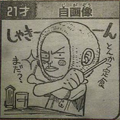
![]()
Personality
According to both himself and his editors, Oda is an ardent worker and perfectionist.[4] By his own estimation, he sleeps only three hours per day during a typical work week.[5]
During his first years at Shueisha, Oda was also noted to be unusually impatient and blunt for an aspiring mangaka, willing to argue with senior mangaka and editors on topics as major as story approval and minor as workplace music. This was gradually reduced through a combination of indulgence from the senior mangaka and discipline from the editors.[6]
However, when interacting with fans - particularly in his SBS columns - Oda usually assumes a very laid-back, eccentric personality, eager to make jokes (especially those involving puns and/or toilet humor) and deprecate himself at any opportunity. Despite his age and status, he freely allows fans to address him with his grade-school nickname "Odacchi" (or the even more intimate "Ei-chan").
Per mangaka custom, Oda rarely allows himself to be photographed or filmed. He generally requests that print interviews be illustrated by his personally-drawn caricatures, and only agrees to video recordings if they take care to avert his face (or cover it up in post-production).
Interests and Hobbies
Oda is a fan of soul music, naming Brook Benton as his favorite in the genre. His other favorite musicians include Bryan Adams, Eminem, and Izumi Kato.[7]
In his spare time, Oda enjoys watching films, both domestic and foreign; among his favorite are Seven Samurai, Nausicaä of the Valley of the Wind, Young Guns, Reservoir Dogs, and The Nightmare Before Christmas. Correspondingly, his favorite directors include Akira Kurosawa, Hayao Miyazaki, Quentin Tarantino, and Tim Burton, along with Baz Luhrmann and Masahiro Makino.[7] [8]
Oda has stated that he enjoys meat, and does not specifically dislike any food. Among Kumamoto's "native" offerings, he particularly recommends horse sashimi (馬刺し , Basashi ? ) and mustard lotusroot (
Relationships
Family
Little is known about Oda's parents. His mother was an ordinary housewife, while his father was a salaryman who oil-painted as a hobby.[4] Oda has at least one sibling – an older sister, whom he has mentioned in his SBS columns.[9] [10]
Eiichiro Oda's wife and her daughters's mother is Chiaki Inaba (稲葉ちあき , Inaba Chiaki ? ), (Kanagawa prefecture, Kantō, Japan, January 4, 1978) a former actress, promoter, model, and "racequeen" in Japan's automobile racing sport since 1992 to early 2000s. She played Nami through a cosplay during Jump Festastage performances in 2002. 27-years-old Oda met her during one of these performances, and after a period of dating of two years, they married on November 7, 2004 in a private wedding. Inaba retired from modeling and performances in 2004 when at the age of 27.
Chiaki Inaba (稲葉ちあき Inaba Chiaki) Chiaki cosplaying as Nami. 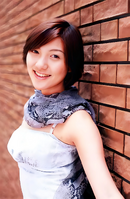
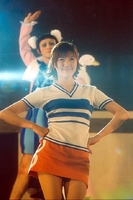
Oda and Inaba have had two daughters, the couple welcomed their first daughter in 2006 and a second daughter who was born in 2009. Virtually nothing else is known about either.
Due to his rigorous work schedule, Oda lives apart from his wife and daughters, receiving visits from them roughly once per week. He usually visits their home during holiday breaks; a apulent mansion located in Kumamoto city where his wife and daughters reside, in addition, the family goes on vacation abroad approximately once a year.
.
Inspirations and Mentors
Oda claims many different mangaka as inspirations and influences, having been an avid manga reader since he was four. He identifies Motoo Abiko - more famously known as Fujiko A. Fujio - as his earliest, with one particular panel from The Monster Kid spurring him to draw endless copies.[11] [12]
As he grew older, Oda gravitated toward Weekly Shonen Jump, admiring everything from Osamu Akimoto's legendary gag series KochiKame to Yudetamago's action-comedy Kinnikuman. Above all else, however, he idolized Akira Toriyama's Dragon Ball, particularly for its depictions of character muscles and mecha; he continues to cite Dragon Ball as his favorite manga, and a greater influence on One Piece than any other single series.[13] Toriyama has, in turn, praised Oda's skills and agreed to a number of collaborations, most notably the crossover one-shot Cross Epoch.
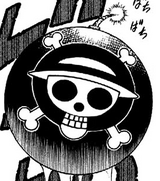
Shortly after One Piece began serialization, Watsuki homaged his former assistant with this panel from Rurouni Kenshin.
During the first few years of his professional career, Oda served as assistant to three established Shonen Jump mangaka: Shinobu Kaitani, Masaya Tokuhiro, and Nobuhiro Watsuki. He continues to hold Tokuhiro (who formally introduced him to Akira Toriyama) and Watsuki in particularly high regard, and has participated in reunion interviews with all three.[14] [15] [16]
Peers and "Rivals"
Oda regards many mangaka of "his" generation with a mixture of camaraderie and rivalry. Among the oldest of these are the mangaka he knew as fellow assistants under Nobuhiro Watsuki — the so-called "Watsuki Gang" consisting of Hiroyuki Takei (best known for Shaman King), Shinya Suzuki (best known for Mr. Fullswing), Mikio Ito (fictionalized into a long-running Easter Egg in One Piece), and Eiji Kumazawa (pseudonym Gin Shinga). On at least one occasion, Oda cited Takei as the most "amazing" of his rivals, capable of drawing things he himself could not.[17]
While not part of the Watsuki Gang, Mitsutoshi Shimabukuro (who had admired Oda since reading Wanted! in Shueisha's then-latest Tezuka Awards collection) also met and befriended Oda in this early period.[18] The pair have remained close since then, and in 2011 Oda agreed to collaborate on a crossover between One Piece and Shimabukuro's then-ongoing Toriko — the only crossover, apart from Cross Epoch, with Oda's direct participation.
However, Oda's most prominent rival is generally considered to be Masashi Kishimoto, whose ninja saga Naruto ran alongside One Piece for fifteen years and was usually the only Jump manga that could challenge it in popularity and volume sales. Throughout their careers, Oda and Kishimoto have maintained a friendly bond, even attending each others' weddings; when Naruto ended in 2014, they performed a cross-tribute, with Naruto's final chapter featuring the Straw Hats' Jolly Roger on Hokage Rock while One Piece's concurrently-published chapter used its title page to depict Luffy sharing a farewell meal with Naruto.[19]
Upon the release of Chapter 1000 of One Piece, several of Oda's fellow mangaka rivals pay tribute in the author's comment section of Shonen Jump by congratulating Oda for achieving this milestone.[20]
History
Early Life
As a child, Oda read many different manga (the earliest he can recall being The Monster Kid). These - along with his father's oil-painting hobby - inspired his dream to become a mangaka, as he believed they made money for doing no "real" work. His favorite television show was Vicky the Viking, a European-coproduced anime which began his lifelong fascination with pirates.[21]
In fifth grade, inspired by Weekly Shonen Jump bestseller Captain Tsubasa, he joined his school's soccer club.[12] It was around this time that Jump began serializing Akira Toriyama's Dragon Ball; on reading its second chapter, Oda was instantly enthralled, and would be heavily influenced by Toriyama's art and storytelling sensibilities for years to come.
Oda began drawing manga in earnest around his second year of junior high, developing ideas and sketches for a pirate serial that would, many years later, become One Piece.[22] [23] During his first year of high school, he chose to quit soccer so he could focus wholly on manga.
Breakthrough: Wanted! (1992-1993)
In 1992, during his senior year of high school, the seventeen-year-old Oda took interest in Shueisha's prestigious Tezuka Awards. Having enjoyed Westerns since seeing Young Guns some time prior, he spent four months constructing his first full-length manga: Wanted!, a "Gag Western" with strong supernatural elements. Proud of his work, but concerned his parents and teachers might disapprove, he submitted it under the pseudonym Tsuki Himizu Kikondo (月火水木金土 , Tsuki Himizu Kikondo ? ).
Ultimately, Wanted! was named Second Class (準入選 , Jun-nyūsen ? ) in the 44th Tezuka Awards, alongside two other works. This won Oda a ¥500,000 cash prize and recognition from many industry professionals, and in early 1993 his work was published in Shueisha's ongoing Mezase Mangaka! (めざせ漫画家! , Mezase Mangaka! ? ) series.[24] Around this time, Oda - under his real name - acceded to his first professional interview, published in Kumamoto City's most prominent newspaper.[25]
In spring of 1993, Oda graduated high school and entered Kyushu Tokai University's architecture program. Soon after, he began submitting more work to Shueisha, unaware that his Tezuka honors had qualified him not for Weekly Shonen Jump, but its Monthly offshoot. On finding his next publication - God's Gift for the Future - in the Monthly line, he sought out the Weekly title's "proper" channel, the somewhat less-renowned Hop☆Step Awards.[6] That October, his Hop☆Step entry Ikki Yako won first place — his first unqualified success as a mangaka.[26]
Professional Career
In early 1994, encouraged by the honors his manga had received (and dreading his freshman exams), Oda dropped out of Kyushu Tokai to pursue a mangaka career in Tokyo, under the authority of editor Kaoru Kushima.
Assistant Years (1994-1997)
Like most mangaka, Oda began his professional career as an assistant for established Shonen Jump creators. His first assistant work was for the last few chapters of Shinobu Kaitani's Midoriyama Police Gang; though only a month long, this tenure gave Oda his first experience with professional manga production, and he cited the sheer beauty of the final drafts (always diminished by Jump's cheap print) as an important inspiration.[17]
After Kaitani left Jump, Oda spent some eighteen months assisting Masaya Tokuhiro through the final year of Jungle King Tar-chan and most of Tokuhiro's subsequent series Kappaman. This was his longest tenure under any single mangaka, and he (despite Tokuhiro's noted reluctance to leave any significant work to assistants) developed much of his technique drafting backgrounds and crowds for both series.[16]
Simultaneously, Oda conceived many more drafts for his own manga, almost all of which were rejected by Kushima. Though their relationship remained civil, Oda did not take Kushima's many criticisms to heart until his one-shot Monsters was allowed publication in 1994's Shonen Jump Autumn Special. Reading his own work at a remove allowed Oda to recognize many of his artistic inadequacies, spurring him to improve.[27]
Once Kappaman ended in mid-1996, Oda began his final assistant tenure, under Nobuhiro Watsuki on Rurouni Kenshin. Watsuki, apart from being one of Jump's most popular new creators, was somewhat more easygoing than Tokuhiro and allowed his assistants greater participation in his work; Oda in particular was credited with conceptualizing the crossdressing swordsman Honjō Kamatari.[28]
However, despite enjoying the atmosphere - and making many new friends - at Watsuki's studio, Oda remained troubled by all the rejections his independent drafts were still facing. Finally, in a "last-resort" bid for publication, he developed the pirate serial he had conceptualized since high school into a draft titled Romance Dawn. To his relief, Romance Dawn impressed Kushima enough to approve further development, and was soon published in that year's Shonen Jump Summer Special, to general praise from readers.[6]
Almost concurrent with Romance Dawn's publication, Oda fell under the purview of a new editor, Takanori Asada, who arranged for him to fill an upcoming gap in Weekly Shonen Jump. Seizing this extremely rare opportunity, Oda produced a second Romance Dawn draft within two weeks, and saw it published to renewed acclaim. Despite this, Asada's superiors remained skeptical of the concept and repeatedly refused to serialize it, forcing Asada to argue on Oda's behalf for several months.[29]
In May of 1997, One Piece was finally approved for serialization in Weekly Shonen Jump, and Oda formally resigned as Watsuki's assistant to begin his career as a full-fledged mangaka.[18]
One Piece (1997-Present)
For Oda, constructing the first chapters of One Piece was relatively straightforward. Knowing Jump customarily gave any new serial around ten installments to gauge reader response, he (with Asada's help) refined the earlier portions of his concept material into eight chapters: seven for a largely self-contained "introduction" arc, and one beginning a second, more elaborate arc.
In July of 1997, Weekly Shonen Jump #34 premiered the first of these chapters, once again titled Romance Dawn. To Oda's surprise - and delight - it ranked higher in fan response than any of its co-features, prefiguring the series' runaway success. In following years, One Piece would expand into a considerable franchise, receiving its first animated adaptation in 1998, a full-length anime series in 1999, and its first video game in 2000.
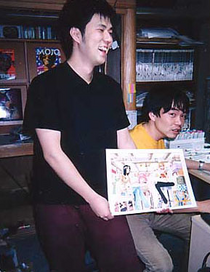
Oda with Chapter 226's color-spread.
In 2002, 27-years-old Eiichiro Oda met then 24-years old Chiaki Inaba (稲葉ちあき, Inaba Chiaki), a young model, promoter, actress and "racequeen" in Japan's automobile racing sport. This woman is who played Nami during the One Piece live action musical made by Shonen Jump Festa through a cosplay, and the two started going out. On november 2004, after two years of relationship, they got married and years later they had two daughters. In 2006, Chiaki Inaba give birth a baby girl, Oda's first daughter. Oda and Inaba become parents again when they welcomed a second daughter who was born in 2009.
In April 2006, Oda unexpectedly fell ill and One Piece was not released that week. However he recovered and resumed One Piece the next week. Because of his recent illness, Oda felt the fans needed to catch up so he created Grand Line Times.
In 2007, at the JUMP Fiesta 2008, in the absence of Shūichi Ikeda, when the voice actors acted out the Red-Hair of Class 3 - Sea Time short, he wore a hot pink wig for the part and explained he would only do this because One Piece was in its tenth year.[30]
He was also involved in writing and directing the tenth One Piece movie, the first movie that he actually wrote the script for, in honor of the tenth anniversary of One Piece.
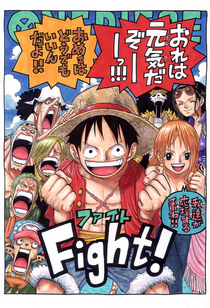
Oda's message to the earthquake victims.
In 2011, after the 2011 Tōhoku earthquake, Oda as well as other mangaka drew messages to the victims.
Future
Oda stated in One Piece Blue that he wanted to create a robot manga after he finished One Piece.[31] However, he later stated that he would never draw any more long-runners because his physical health could not stand it.[32]
Works
| Title | Classification | Further Notes |
|---|---|---|
| Wanted! ( | One-shot | Second-Class Winner in the 44th Tezuka Awards (1992). Published in:
|
| God's Gift for the Future (神から未来のプレゼント) | One-shot | Published in:
|
| Ikki Yako (一鬼夜行) | One-shot | First Class Winner in the 104th Hop☆Step Awards (1993). Published in:
|
| Midoriyama Police Gang (翠山ポリスギャング) | Assistance (Ch. 17-20) | Published in:
|
| Monsters ( | One-shot | Published in:
|
| Jungle King Tar-chan (ジャングルの王者ターちゃん) | Assistance (Ch. 309-347)[33] | Published in:
|
| Watery Friend Kappaman (水のともだちカッパーマン) | Assistance (Ch. 1-22) | Published in:
|
| Rurouni Kenshin (るろうに剣心) | Assistance (Ch. 95-115) | Published in:
|
| Romance Dawn (Version 1) ( | One-shot | Published in:
|
| Romance Dawn (Version 2) ( | One-shot | Published in:
|
| One Piece | Serial | Published in:
|
| Cross Epoch ( | One-shot collaboration | Crossover between One Piece and Akira Toriyama's Dragon Ball. Published in:
|
| The True Food! Devil Fruit!! (実食! 悪魔の実!!) | One-shot collaboration | Crossover between One Piece and Mitsutoshi Shimabukuro's Toriko. Published in:
|
Cameos
- Voice of Odacchi in Dream Soccer King!.
- Played Shanks in the 2008 Jump Festa.[30]
- Name appeared on the mirror in Episode 21 (minute 3:09), on a book in Episode 70 (minute 18:21) as an Easter Egg and among Ohara's books in Episode 278 (minute 12:49).
- Oda's avatar (with the fish head on his head) is a support character in Gigant Battle and Gigant Battle 2: he draws a manga panel which traps opponents.
- Strangely, Eiichiro Oda is in the Japanese Fan Poll, despite the fact that he has never included himself in any issue of the manga (except the SBS).
- In the second fan poll, he is ranked 25th.
- In the third, he is ranked 48th.
- In the fourth, he is ranked 31st.
- In the fifth, he is ranked 50th, which made him tied with Marguerite.
- In the sixth, he is ranked 40th.
Odacchi in "Dream Soccer King!". Oda's name and "ONEPIECE" can be found on the spines of books in Episode 70. Note the use of Nihon-shiki romanization. Another easter egg with Oda's name (upper left).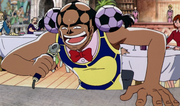
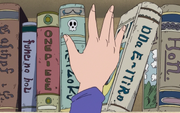
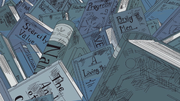
Working Method
Like many other mangaka, Eiichiro Oda uses his signature tools to draw his manga. To make sketches and starting steps of page-drawing, he uses (like many other artists around the world, not only mangaka) pencils in conjunction with erasers and an art gum eraser to fix errors. To ink the pages, Oda utilizes the G-Pen, Maru Pen and sharp refillable pens for inking. For making corrections after inking, he uses white ink.
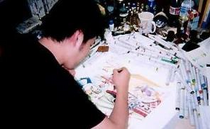
Oda painting color pages with Copic markers.
To paint the color pages, Oda uses Copic markers, a brand of refillable color markers that several other mangaka use for that purpose. Although it was not confirmed, he has recently shown a tendency to use watercolors for painting, too.
Like many other manga artists, Oda seems to not use digital methods. This is a characteristic he shares with many mangaka, in terms of making a manga the most handcrafted as possible.
He commented in one of the first SBS sessions that he is usually a few (approximately 5) chapters farther along than the Shonen Jump ongoing chapters, having a difference of time between when a chapter is finished and sent to Shueisha to be published in the magazine of about 5 weeks (sometimes more, sometimes less). He has also commented on other occasion that he has an average of 5 assistants that help him in the inking and penciling details or backgrounds and application of adhesive graytones.
He has commented that he prefers painting black instead of using graytones, making his art almost black and white, with no gray colors. He uses graytones only to perform special effects (like shadowing a character in a dramatic scene, to demonstrate an underwater panel, to show a scene in darkness or to separate planes), not to color (the only exception of this is for Shanks' hair).
Storyline Format
Since the manga focuses on the progress of the Straw Hat crew as it journeys through the Grand Line, it is not without a "format". Some of these were standard elements Oda had used before. As witnessed in his other one-shots, Oda likes to put his characters in extreme situations that they must overcome. While many of the situations are quite serious, he also enjoys placing a significant amount of humor into the series.
Oda is renowned for over using the sound effect "Don" and for giving his characters their own unique Laughter Style. Oda also favors drawing animals, and is accountable for the numerous appearances of animals within the storyline. He has also been reported to enjoy drawing ships for the storyline. He often adds plot elements into the storyline and comes back to them many story arcs later, frequently with plot twists related to them, such as the case with the introduction of Luffy's grandfather, Monkey D. Garp, who was simply introduced as "Garp" in a front page story arc. He also introduced his one-shot "Monsters" into the storyline when there was no indication that any of his past works were going to be included.
Art Evolution
At the start of One Piece Oda was reported as worried about his art style. At the time it was more favored to have big-eyed characters than it was to have the more old fashioned dot-eyed style. One Piece is also noted for its numerous bizarre and extreme character designs, which became more and more common and exaggerated as the series progressed. One Piece's distinct style has changed quite a bit over its decade-long run. In the beginning it used many thick lines, giving the art a round, bouncy, cartoon like look. Over time the lines became thinner and crosshatching and line shading is now used extensively.
The characters' features have become more loose to the point where Zoro, for example, can look buffoonish one frame and a hard-boiled swordsman the next. Luffy can appear more grown up at one point before once again becoming more child-like later on. This carries over to many other characters. Chopper did not start out looking as chibi as he does now, though he was always considered cute.
The backgrounds and layouts were more simple in comparison to more recent ones. While they were functional and well drawn, the earlier panels do not quite reach the complexity that they have now.
The change in style is actually extremely appropriate, as the art seems to get more detailed and emotionally intense as the story gets progressively darker and more mature.
A panel from Romance Dawn Version 1… …and a similar panel from the One Piece version. The front cover of "Wanted!" showing various more common character designs. Ryuma slaying a dragon in "Monsters"… …and Zoro pulling off a similar move on Ryuma in Chapter 467 of One Piece. Luffy, Nami and the Red Haired Pirates on the cover of Chapter 1. The Straw Hats on a poster made with the covers of chapters 999 and 1000. 



![]()







Signature
Oda's signature. Oda's updated signature. 

Trivia
- Oda was nicknamed Odacchi (オダッチ , Odacchi ? ) by his friends at a relatively young age. This was the basis for his character's name in Dream Soccer King, and many – particularly fans in his SBS Columns – continue to address him with it.
- Oda's name often appears on the spines of books in the anime.
- Oda's favorite real pirate is Blackbeard (Edward Teach).[34]
- According to Oda in an interview for Shonen Jump in the early days of One Piece's run, his favorite villain in One Piece is Buggy the Clown (he joked that he literally threw him together). Oda has also claimed if he could eat any of the Devil Fruits, he would eat the Bara Bara no Mi.
- Oda is a fan of Akira Toriyama. In a Jump interview, when asked about his inspirations, he said, "I mirrored many traits and tropes for Luffy off of Son Goku. By far the manga that inspired me the most was Dragon Ball and I think the same could be said for many other mangaka. But the simple fact is, if there was no Dragon Ball, there would be no One Piece."
- Oda was seen on the verge of tears after the Straw Hats' voice actors asked the audience to say "Odacchi, itsumo arigatou" in a Jump Festa event. He then asked if they had planned that just now. Mayumi Tanaka (Luffy's voice actor) and Kappei Yamaguchi (Usopp's voice actor) responded that they planned that just now, when Oda was still blindfolded after a certain game they played.
- On that same day, Oda was wearing a fish head on his head, known as his other trademark (other than Pandaman).
- In line with SBS tradition of readers deciding the birthdays for characters, he agreed to a question requesting that Eiichiro Oda's birthday be on January (ichi = 1) 6th (ro = 6).[1]
- In a Shonen Jump question asking "If you could be any manga character, who would you be?" Oda said he would want to be Nico Robin so that he could "sprout hands and draw manga twenty times as fast."
- In the Oricon survey, as an answer to the question "The mangaka who changed the manga history" Eiichiro Oda took the 4th place.[35]
- Oda is a fan of rakugo.
- Oda has a near-life size giraffe statue in his house.
References
External Links
- Eiichiro Oda at Wikipedia
- 尾田栄一郎 at Ja.Wikipedia
- Destination Paradise – One of the oldest (English-language) One Piece fan-sites, last updated in 2002. Features:
- Oda Index – Compiles biography of Oda, as well as translations of all his Shonen Jump comments (up to early 2002) and several different interviews
- The Grand Line – Small but in-depth One Piece fan-site, last updated in 2013. Features:
- Interviews With Oda – Translations of ten separate interviews with Oda (dating from 2002 to 2011)
- Oda's Deep Thoughts – Translations of all of Oda's Shonen Jump comments (up to late 2013)
- The Diary of Hitto Yosenabe - Japanese One Piece fan-site, last updated in 2012. Features:
- Dialog, Interview, and Art List - Extensive index of Oda's writings and art in chronological order (some image-links broken).
- LOGPIECE – Japanese One Piece fan-site, still active as of 2020. Features:
- Grand Navigation – Real-life timeline charting One Piece developments (mostly focusing on the manga); paired with a number of quotations from Oda, all sourced
- Complete Works – Near-exhaustive index of Oda's works, ranging from standard manga chapters (with backgrounds on their original Shonen Jump serializations) to miscellaneous tablet scribbles
| [v ·e ·?] | |
|---|---|
| Primary Works: | Wanted! • God's Gift for the Future • Ikki Yako • Romance Dawn (V.1 • V.2) • One Piece (Monsters • Author's Notes • SBS • One Para) |
| Collaborations and Part-Works: | Cross Epoch • One Piece Film: Strong World • One Piece x Toriko |
| Misc. Works and Designs: | Ganzack, Plesiosaur, Medaka, Herring, and Skid (Defeat Him! The Pirate Ganzack) • Joke (Adventure in the Ocean's Navel) • Guide Parrot(s) (Big Secret Treasure of the Seven Phantom Islands) • Noko and Tatsu (Ocean's Dream!) • Don Accino (Ice Hunter Arc) • Musshuru (Episode of Chopper Plus) • Gaburi (Unlimited Cruise) • Chameleone (Premier Show 2012) • Neo Marines (Film Z) • Patrick Redfield and Pato (Unlimited World Red) • Byrnndi World (3D2Y) • Isaac and Jeanne (World Seeker) |
| Related: | Weekly Shonen Jump • Odacchi |
| [v ·e ·?] | |||||||||||
|---|---|---|---|---|---|---|---|---|---|---|---|
| Creator: | Eiichiro Oda | ||||||||||
| Content: | Story Arcs (Cover Stories • Where They Are Now) | ||||||||||
| |||||||||||
| |||||||||||
| |||||||||||
How to Draw Hot Videl Final Chapters Manga Art
Source: https://onepiece.fandom.com/wiki/Eiichiro_Oda
0 Response to "How to Draw Hot Videl Final Chapters Manga Art"
ارسال یک نظر